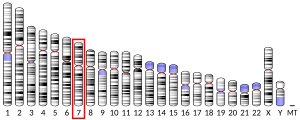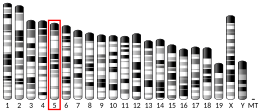LMTK2
Serine/threonine-protein kinase LMTK2 also known as Lemur tyrosine kinase 2 (LMTK2) is an enzyme that in humans is encoded by the LMTK2 gene.[5][6]
Function
[edit]The LMTK2 enzyme belongs to both the protein kinase and the tyrosine kinase families. It contains N-terminus transmembrane helices and a long C-terminal cytoplasmic tail with serine/threonine kinase activity. This protein interacts with several other proteins, such as androgen receptor, inhibitor-2 (Inh2), protein phosphatase-1 (PP1C), p35, and myosin VI. It phosphorylates other proteins, and is itself also phosphorylated when interacting with cyclin-dependent kinase 5 (cdk5)/p35 complex. This protein is involved in nerve growth factor (NGF)-TrkA signalling, and also plays a critical role in endosomal membrane trafficking. Mouse studies suggested an essential role of this protein in spermatogenesis.[6]
Clinical significance
[edit]Loss of LMTK2 has been implicated to play a role in development of prostate cancer.[7]
Interactions
[edit]LMTK2 has been shown to interact with PPP1CA,[8] Cyclin-dependent kinase 5[9] and PPP1R2.[8]
References
[edit]- ^ a b c GRCh38: Ensembl release 89: ENSG00000164715 – Ensembl, May 2017
- ^ a b c GRCm38: Ensembl release 89: ENSMUSG00000038970 – Ensembl, May 2017
- ^ "Human PubMed Reference:". National Center for Biotechnology Information, U.S. National Library of Medicine.
- ^ "Mouse PubMed Reference:". National Center for Biotechnology Information, U.S. National Library of Medicine.
- ^ Kawa S, Fujimoto J, Tezuka T, Nakazawa T, Yamamoto T (Mar 2004). "Involvement of BREK, a serine/threonine kinase enriched in brain, in NGF signalling". Genes to Cells. 9 (3): 219–32. doi:10.1111/j.1356-9597.2004.00714.x. PMID 15005709. S2CID 26059849.
- ^ a b "Entrez Gene: LMTK2 lemur tyrosine kinase 2".
- ^ Shah K, Bradbury NA (Jun 2015). "Lemur Tyrosine Kinase 2, a novel target in prostate cancer therapy". Oncotarget. 6 (16): 14233–46. doi:10.18632/oncotarget.3899. PMC 4546463. PMID 26008968.
- ^ a b Wang H, Brautigan DL (Dec 2002). "A novel transmembrane Ser/Thr kinase complexes with protein phosphatase-1 and inhibitor-2". The Journal of Biological Chemistry. 277 (51): 49605–12. doi:10.1074/jbc.M209335200. PMID 12393858.
- ^ Kesavapany S, Lau KF, Ackerley S, Banner SJ, Shemilt SJ, Cooper JD, Leigh PN, Shaw CE, McLoughlin DM, Miller CC (Jun 2003). "Identification of a novel, membrane-associated neuronal kinase, cyclin-dependent kinase 5/p35-regulated kinase". The Journal of Neuroscience. 23 (12): 4975–83. doi:10.1523/JNEUROSCI.23-12-04975.2003. PMC 6741199. PMID 12832520.
Further reading
[edit]- Eeles RA, Kote-Jarai Z, Giles GG, Olama AA, Guy M, Jugurnauth SK, Mulholland S, Leongamornlert DA, Edwards SM, Morrison J, Field HI, Southey MC, Severi G, Donovan JL, Hamdy FC, Dearnaley DP, Muir KR, Smith C, Bagnato M, Ardern-Jones AT, Hall AL, O'Brien LT, Gehr-Swain BN, Wilkinson RA, Cox A, Lewis S, Brown PM, Jhavar SG, Tymrakiewicz M, Lophatananon A, Bryant SL, Horwich A, Huddart RA, Khoo VS, Parker CC, Woodhouse CJ, Thompson A, Christmas T, Ogden C, Fisher C, Jamieson C, Cooper CS, English DR, Hopper JL, Neal DE, Easton DF (Mar 2008). "Multiple newly identified loci associated with prostate cancer susceptibility". Nature Genetics. 40 (3): 316–21. doi:10.1038/ng.90. PMID 18264097. S2CID 30968525.
- Chibalina MV, Seaman MN, Miller CC, Kendrick-Jones J, Buss F (Dec 2007). "Myosin VI and its interacting protein LMTK2 regulate tubule formation and transport to the endocytic recycling compartment". Journal of Cell Science. 120 (Pt 24): 4278–88. doi:10.1242/jcs.014217. PMC 2621362. PMID 18029400.
- Olsen JV, Blagoev B, Gnad F, Macek B, Kumar C, Mortensen P, Mann M (Nov 2006). "Global, in vivo, and site-specific phosphorylation dynamics in signaling networks". Cell. 127 (3): 635–48. doi:10.1016/j.cell.2006.09.026. PMID 17081983. S2CID 7827573.
- Wang H, Brautigan DL (Nov 2006). "Peptide microarray analysis of substrate specificity of the transmembrane Ser/Thr kinase KPI-2 reveals reactivity with cystic fibrosis transmembrane conductance regulator and phosphorylase". Molecular & Cellular Proteomics. 5 (11): 2124–30. doi:10.1074/mcp.M600188-MCP200. PMID 16887929.
- Kesavapany S, Lau KF, Ackerley S, Banner SJ, Shemilt SJ, Cooper JD, Leigh PN, Shaw CE, McLoughlin DM, Miller CC (Jun 2003). "Identification of a novel, membrane-associated neuronal kinase, cyclin-dependent kinase 5/p35-regulated kinase". The Journal of Neuroscience. 23 (12): 4975–83. doi:10.1523/JNEUROSCI.23-12-04975.2003. PMC 6741199. PMID 12832520.
- Wang H, Brautigan DL (Dec 2002). "A novel transmembrane Ser/Thr kinase complexes with protein phosphatase-1 and inhibitor-2". The Journal of Biological Chemistry. 277 (51): 49605–12. doi:10.1074/jbc.M209335200. PMID 12393858.
- Kikuno R, Nagase T, Ishikawa K, Hirosawa M, Miyajima N, Tanaka A, Kotani H, Nomura N, Ohara O (Jun 1999). "Prediction of the coding sequences of unidentified human genes. XIV. The complete sequences of 100 new cDNA clones from brain which code for large proteins in vitro". DNA Research. 6 (3): 197–205. doi:10.1093/dnares/6.3.197. PMID 10470851.
This article incorporates text from the United States National Library of Medicine, which is in the public domain.




